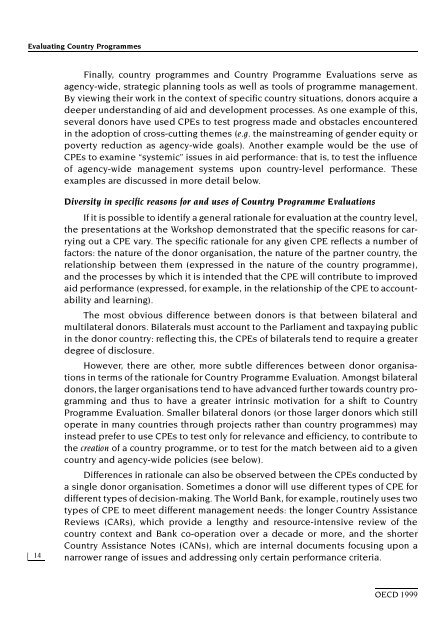Evaluating Country Programmes - OECD Online Bookshop
Evaluating Country Programmes - OECD Online Bookshop
Evaluating Country Programmes - OECD Online Bookshop
You also want an ePaper? Increase the reach of your titles
YUMPU automatically turns print PDFs into web optimized ePapers that Google loves.
<strong>Evaluating</strong> <strong>Country</strong> <strong>Programmes</strong><br />
14<br />
Finally, country programmes and <strong>Country</strong> Programme Evaluations serve as<br />
agency-wide, strategic planning tools as well as tools of programme management.<br />
By viewing their work in the context of specific country situations, donors acquire a<br />
deeper understanding of aid and development processes. As one example of this,<br />
several donors have used CPEs to test progress made and obstacles encountered<br />
in the adoption of cross-cutting themes (e.g. the mainstreaming of gender equity or<br />
poverty reduction as agency-wide goals). Another example would be the use of<br />
CPEs to examine “systemic” issues in aid performance: that is, to test the influence<br />
of agency-wide management systems upon country-level performance. These<br />
examples are discussed in more detail below.<br />
Diversity in specific reasons for and uses of <strong>Country</strong> Programme Evaluations<br />
If it is possible to identify a general rationale for evaluation at the country level,<br />
the presentations at the Workshop demonstrated that the specific reasons for carrying<br />
out a CPE vary. The specific rationale for any given CPE reflects a number of<br />
factors: the nature of the donor organisation, the nature of the partner country, the<br />
relationship between them (expressed in the nature of the country programme),<br />
and the processes by which it is intended that the CPE will contribute to improved<br />
aid performance (expressed, for example, in the relationship of the CPE to accountability<br />
and learning).<br />
The most obvious difference between donors is that between bilateral and<br />
multilateral donors. Bilaterals must account to the Parliament and taxpaying public<br />
in the donor country: reflecting this, the CPEs of bilaterals tend to require a greater<br />
degree of disclosure.<br />
However, there are other, more subtle differences between donor organisations<br />
in terms of the rationale for <strong>Country</strong> Programme Evaluation. Amongst bilateral<br />
donors, the larger organisations tend to have advanced further towards country programming<br />
and thus to have a greater intrinsic motivation for a shift to <strong>Country</strong><br />
Programme Evaluation. Smaller bilateral donors (or those larger donors which still<br />
operate in many countries through projects rather than country programmes) may<br />
instead prefer to use CPEs to test only for relevance and efficiency, to contribute to<br />
the creation of a country programme, or to test for the match between aid to a given<br />
country and agency-wide policies (see below).<br />
Differences in rationale can also be observed between the CPEs conducted by<br />
a single donor organisation. Sometimes a donor will use different types of CPE for<br />
different types of decision-making. The World Bank, for example, routinely uses two<br />
types of CPE to meet different management needs: the longer <strong>Country</strong> Assistance<br />
Reviews (CARs), which provide a lengthy and resource-intensive review of the<br />
country context and Bank co-operation over a decade or more, and the shorter<br />
<strong>Country</strong> Assistance Notes (CANs), which are internal documents focusing upon a<br />
narrower range of issues and addressing only certain performance criteria.<br />
<strong>OECD</strong> 1999

















![CQE=U]^\]Z: KAZAKHSTAN - OECD Online Bookshop](https://img.yumpu.com/3915768/1/190x253/cqeuz-kazakhstan-oecd-online-bookshop.jpg?quality=85)